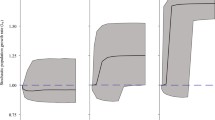Summary
A range of published 3-parameter, single-species models are compared using possums in New Zealand as an example. Most models yield similar population growth curves and similar estimates of maximum sustainable yield (MSY). A new model of competition for refuges, and interactive models of competition for food, both yield growth curves peaked to the right. In the second case, the relationship between the shape of the curve and the parameters of the interactive model is described. Three management consequences of asymmetric (rightward-peaked) growth as opposed to logistic growth are discussed. First, where the animal is a pest a greater control effort is required to reduce density. Second, for sustained yield harvesting the best policy is an adaptive one which initially requires no knowledge of the shape of the growth curve. Third, sustainable yields may be 50% higher than those predicted by the simple logistic model.
Similar content being viewed by others
References
Bellows TS Jr (1981) The descriptive properties of some models for density dependence. J Anim Ecol 50:139–156
Caughley G (1976) Wildlife management and the dynamics of ungulate populations. Applied Biology 1:183–246
Caughley G (1977) Analysis of vertebrate populations. John Wiley and Sons, London New York Sydney Toronto
Caughley G, Lawton JH (1981) Plant-herbivore systems. In: May RM (ed) Theoretical Ecology, Second Edition. Black-well Scientific Publications, Oxford London Edinburgh Melbourne, p 132–166
Clark CW (1976) Mathematical bioeconomics. John Wiley and Sons, London New York Sydney Toronto
Clout MN (1977) The ecology of the possum (Trichosurus vulpecula Kerr) in Pinus radiata plantations. Unpublished PhD thesis, University of Auckland
Clout MN, Barlow ND (1982) Exploitation of brushtail possum populations in theory and practice. NZ J Ecol 5:29–35
Coleman JD, Gillman A, Green WQ (1980) Forest patterns and possum densities within podocarp/mixed hardwood forests on Mt Bryan O'Lynn, Westland. NZ J Ecol 3:69–84
Crawley MC (1973) The live-trapping study of Australian brush-tailed possums, Trichosurus vulpecula (Kerr) in the Orongorongo Valley, Wellington, New Zealand. Aust J Zool 21:75–90
Dunnet GM (1964) A field study of local populations of the brush-tailed possum Trichosurus vulpecula in eastern Australia. Proc Zool Soc Lond 142:655–695
Fitzgerald AE (1978) Aspects of the food and nutrition of the brush-tailed opossum, Trichosurus vulpecula (Kerr, 1972), Marsupialia: Phalangeridae, in New Zealand. In: Montgomery GG (ed) The Ecology of Arboreal Folivores. Smithsonian Institution Press, Washington, D.C., pp 289–313
Fowler CW (1981) Comparative population dynamics in large mammals. In: Fowler CW, Smith, TD (eds) Dynamics of large mammal populations. John Wiley and Sons, London New York Sydney Toronto, pp 437–455
Gilpin ME, Case TJ, Ayala FJ (1976) θ-selection. Math Biosci 32:131–139
Goodman D (1980) The maximum yield problem: distortion in the yield curve due to age-structure. Theor pop Biol 18:160–174
Hassell MP, Lawton JH, May RM (1976) Patterns of dynamical behaviour in single-species populations. J Anim Ecol 45:471–486
Holling CS (ed) (1978) Adaptive envionmental assessment and management. John Wiley and Sons, Chichester New York Brisbane Toronto
Jones R, Hall WB (1973) A simulation model for studying the population dynamics of some fish species. In Bartlett MS, Hiorns RW (eds) The mathematical theory of the dynamics of biological populations. Academic Press, London New York, pp 35–59
Kean RI, Pracy LT (1953) Effects of the Australian oppossum (Trichosurus vulpecula Kerr) on indigenous vegetation in New Zealand. Proc 7th Pacific Science Congress 4:1–8
May RM (1981) Models for single populations. In: May RM (ed) Theoretical Ecology, Second Edition. Blackwell Scientific Publications, Oxford London Edinburgh Melbourne, pp 5–29
May RM, Oster GF (1976) Bifurcation and dynamic complexity in simple ecological models. Amer Nat 110:573–599
May RM, Beddington JR, Clark CW, Holt SJ, Laws RM (1979) Management of multispecies fisheries. Science 205:267–277
Maynard-Smith J (1974) Models in Ecology. Cambridge University Press, Cambridge London New York Melbourne
Noy-Meir I (1975) Stability of grazing systems: an application of predator-prey graphs. J Ecol 63:459–481
Pella JJ, Tomlinson PK (1969) A generalised stock production model. Inter-Amer Trop Tuna Comm Bull 13:420–496
Pennycuick CJ, Compton RM, Beckingham L (1968) A computer model for simulating the growth of population or of two interacting populations. J Theor Biol 18:316–29
Pomerantz MJ, Thomas WR, Gilpin ME (1980) Asymmetries in population growth regulated by intra-specific competition: empirical studies and model tests. Oecologia 47:311–322
Schoener TW (1973) Population growth regulated by intraspecific computation for energy or time: some simple representations. Theor Pop Biol 4:56–84
Smith MJ, Brown BK, Frith HJ (1969) Breeding of the brush-tailed possum Trichosurus vulpecula (Kerr) in New South Wales. CSIRO Wildlife Research 14:181–193
Thomas WR, Pomerantz MJ, Gilpin ME (1980) Chaos, asymmetric growth and group selection for dynamical stability. Ecology 61:1312–1320
Warburton B (1978) Foods of the Australian brush-tailed opossum (Trichosurus vulpecula) in an exotic forest. NZ J Ecol 1:126–131
Ward GD (1978) Habitat use and home range of radio-tagged opossums Trichosurus vulpecula (Kerr) in New Zealand lowland forest. In: Montgomery GG (ed) The Ecology of Arboreal Folivores. Smithsonian Institution Press Washington, D.C., pp 267–287
Author information
Authors and Affiliations
Rights and permissions
About this article
Cite this article
Barlow, N.D., Clout, M.N. A comparison of 3-parameter, single-species population models, in relation to the management of brushtail possums in New Zealand. Oecologia 60, 250–258 (1983). https://doi.org/10.1007/BF00379528
Received:
Issue Date:
DOI: https://doi.org/10.1007/BF00379528




